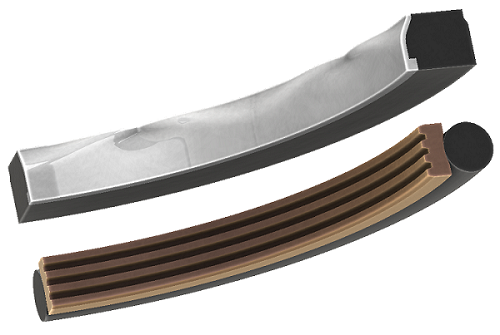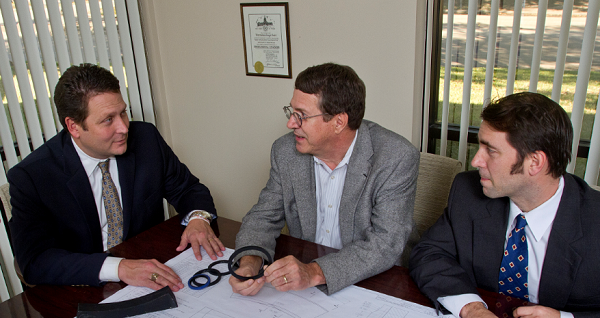
Introduction
BDRP Seals are featured in the September 17, 2020 “Fluid Power Journal” article “Kalsi Engineering Releases New Class of High-Pressure Seals”. The article focuses on the pressure and speed capacity of BDRP Seals, which far exceeds that of the cap seals used in the fluid power industry.
The image above compares a BDRP Seal (top) to a typical cap seal (bottom). Cap seals have been in use since the 1950s and consist of a plastic cap that is loaded against the shaft by an O-ring. The cap is typically manufactured from reinforced PTFE to reduce friction, and often incorporates grooves to increase contact pressure by reducing area. Typically, the caps are radially thick to accommodate the wear that occurs in high pressure operation.
BDRP Seals have an extrusion resistant high-performance plastic liner that is bonded to an elastomer seal body and incorporates hydrodynamic waves that lubricate the liner during rotation. Like cap seals, BDRP Seals can operate with pressure acting in either direction.
Issues with using cap seals as rotary oil seals
Cap seals experience significant friction, wear, and seal-generated heat — especially when operated at higher pressures and speeds. The heat degrades the material properties of the cap and the O-ring, accelerating the compression set of the O-ring. As a result of cap wear and O-ring compression set, sealing contact with the shaft can be lost.
Unintended slippage between the cap and the O-ring often occurs, generating significant heat. The heat cannot escape because the thermal conductivity of seal materials is extremely low. This further accelerates the compression set of the O-ring and loss of sealing contact force. The list of cap seal issues goes on but requires a detailed technical discussion that is beyond the scope of this blog.
The advantages of BDRP Seals over cap seals
BDRP Seals incorporate hydrodynamic waves that pump a film of oil into the dynamic sealing interface during rotation, causing the seal to hydroplane on the oil film. This hydroplaning action dramatically reduces friction, wear, and seal-generated heat, compared to cap seals. This means the liner does not have to be thick to accommodate wear. This allows it to flex to conform to the shaft, eliminating the need for grooves to increase sealing contact force. The hydroplaning action also means that the liner material can be selected for pressure capability, rather than low friction characteristics.
The liner is bonded to the elastomer portion of the BDRP Seal during the molding operation that forms the seal. This prevents the liner from slipping relative to the elastomer energizing portion of the seal. These features allow BDRP Seals to survive speed and pressure combinations that quickly destroy cap seals.
Using BDRP™-type oil seals in your equipment
Contact our staff to discuss the use of BDRP Seals in your high-pressure rotating equipment. We also offer implementation guidance in our seal handbook.

